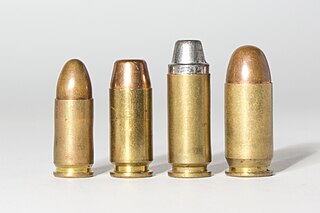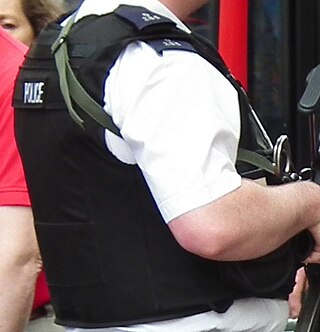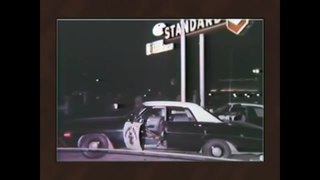
A bulletproof vest, also known as a ballistic vest or bullet-resistant vest, is a type of body armour designed to absorb impact and prevent the penetration of firearm projectiles and explosion fragments to the torso. The vest can be either soft—as worn by police officers, security personnel, prison guards, and occasionally private citizens to protect against stabbing attacks or light projectiles—or hard, incorporating metallic or para-aramid components. Soldiers and police tactical units typically wear hard armour, either alone or combined with soft armour, to protect against rifle ammunition or fragmentation. Additional protection includes trauma plates for blunt force and ceramic inserts for high-caliber rounds. Bulletproof vests have evolved over centuries, from early designs like those made for knights and military leaders to modern-day versions. Early ballistic protection used materials like cotton and silk, while contemporary vests employ advanced fibers and ceramic plates. Ongoing research focuses on improving materials and effectiveness against emerging threats.

The .38 Special, also commonly known as .38 S&W Special, .38 Smith & Wesson Special, .38 Spl, .38 Spc, or 9×29mmR is a rimmed, centerfire cartridge designed by Smith & Wesson.

Zylon (IUPAC name: poly(p-phenylene-2,6-benzobisoxazole)) is a trademarked name for a range of thermoset liquid-crystalline polyoxazole. This synthetic polymer material was invented and developed by SRI International in the 1980s and manufactured by Toyobo. In generic usage, the fiber is referred to as PBO.

The 9×19mm Parabellum is a rimless, centerfire, tapered firearms cartridge.

The FN Five-seven is a semi-automatic pistol designed and manufactured by FN Herstal in Belgium. The pistol is named for the 5.7×28mm cartridge's bullet diameter, and the trademark's capitalization style is intended to emphasize the manufacturer's initials—FN.

A flak jacket or flak vest is a form of body armor. A flak jacket is designed to provide protection from case fragments ("frag") from high explosive weaponry, such as anti-aircraft artillery, grenade fragments, very small pellets used in shotguns such as the "Birdshot", and other lower-velocity projectiles. It is not designed to protect against bullets fired from most small arms such as rifles or handguns. However flak jackets are able to sustain certain gunshots, depending on the angle at which the shot was fired, the caliber of the bullet, the speed of the projectile and the range from which the shot was fired.

Body armor, personal armor, armored suit (armoured) or coat of armor, among others, is armor for a person's body: protective clothing or close-fitting hands-free shields designed to absorb or deflect physical attacks. Historically used to protect military personnel, today it is also used by various types of police, private security guards, or bodyguards, and occasionally ordinary citizens. Today there are two main types: regular non-plated body armor for moderate to substantial protection, and hard-plate reinforced body armor for maximum protection, such as used by combatants.
Combat pistol shooting is a modern martial art that focuses on the use of the handgun as a defensive weapon for self defense, or for military and police use. Like most martial arts, combat pistol shooting is practiced both for defense and for sport.

A stab vest or stab proof vest is a reinforced piece of body armor, worn under or over other items of clothing, which is designed to resist knife attacks to the chest, back and sides.
Armor Holdings, Inc. was an American manufacturer of military, law enforcement, and personnel safety equipment. It was acquired by BAE Systems on July 31, 2007 and renamed BAE Systems Mobility & Protection Systems. The divisions have been reorganised within BAE Systems Land and Armaments.

S&W Centennial is a family of revolvers made by Smith & Wesson on the "J-Frame". Depending upon caliber, the cylinder holds either 5, 6, 7, or 8 cartridges. Centennials feature a fully enclosed (internal) hammer, which makes them Double Action Only (DAO) firearms. Like all other "J-frame" Smith & Wesson revolvers, they have a swing-out cylinder. Centennial models have been made in different versions like PD "Personal Defense", LS "Lady Smith", and M&P "Military & Police"

The Colt 2000 or All American 2000 is a polymer or aluminum-alloy framed, locked-breech, rotating barrel, semiautomatic, 9 mm handgun with a magazine capacity of 15 rounds manufactured by Colt.

The Newhall incident, also called the Newhall massacre, was a shootout on April 5–6, 1970, in Valencia, California, between two heavily armed criminals and four officers of the California Highway Patrol (CHP). In less than five minutes, the four CHP officers were killed and another man was pistol-whipped in what was at the time the deadliest day in California law enforcement history.
Lester D. Shubin was an American research chemist who developed Kevlar for the use in ballistic vests. Kevlar's use in ballistic vests was later expanded for use in all types of personal armor.
Lee E. Jurras was an American firearm cartridge designer, known for creation of the Super Vel line of cartridges, and groundbreaking developments in hollow-point ammunition.

The FN 5.7×28mm is a small-caliber, high-velocity, smokeless-powder, rebated, non-tapered, bottleneck, centerfire cartridge designed for pistols and personal defense weapons (PDW) uses, manufactured by FN Herstal. It is similar in length to the .22 WMR and .22 Hornet. Unlike many new cartridges, it has no parent case; the complete package was developed from scratch by FN.
Gun Digest Media is an American publisher specializing in firearms, shooting, ammunition reloading and concealed carry magazines and books. Its publications include Gun Digest Magazine, GunDigest.com, and the Gun Digest Annual. The brand was founded in 1944 with the release of its annual book, making Gun Digest one of the oldest firearms-specific publishers in the nation. Gun Digest is a sister publication to RECOIL, RECOIL Offgrid, RECOIL Carnivore, and Blade Magazine.
Second Chance, A Second Chance, The Second Chance, or 2nd Chance may refer to:
On November 23, 2012, Jordan Davis, a black American 17-year-old boy, was murdered at a Gate Petroleum gas station in Jacksonville, Florida, United States, by Michael David Dunn, a white 45-year-old software developer, following an argument over loud music played by Davis and his three friends, in what was believed to be a racially motivated shooting.
Bleecker Street Media LLC is an independent American film company that specializes in film distribution. The company is based in New York City and named after 65 Bleecker Street, the street address of founder Andrew Karpen's prior company Focus Features. Founded in 2014, the studio was established with the goal to distribute "smart house" films that combine the entertainment of studio blockbusters with the artistic indie allure.











